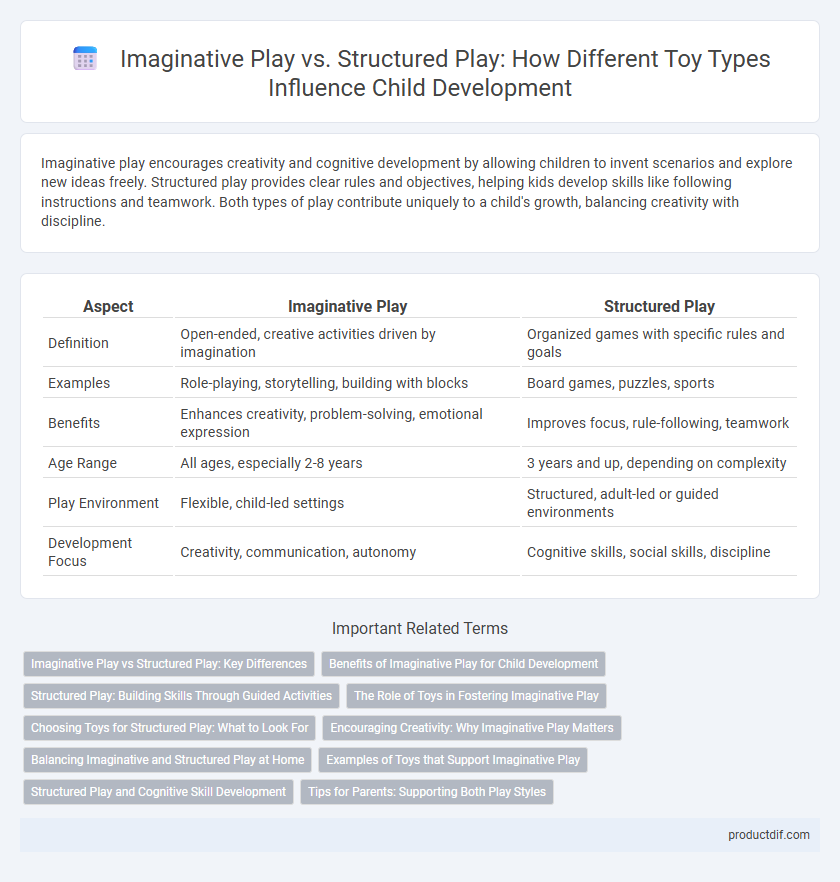Imaginative play encourages creativity and cognitive development by allowing children to invent scenarios and explore new ideas freely. Structured play provides clear rules and objectives, helping kids develop skills like following instructions and teamwork. Both types of play contribute uniquely to a child's growth, balancing creativity with discipline.
Table of Comparison
| Aspect | Imaginative Play | Structured Play |
|---|---|---|
| Definition | Open-ended, creative activities driven by imagination | Organized games with specific rules and goals |
| Examples | Role-playing, storytelling, building with blocks | Board games, puzzles, sports |
| Benefits | Enhances creativity, problem-solving, emotional expression | Improves focus, rule-following, teamwork |
| Age Range | All ages, especially 2-8 years | 3 years and up, depending on complexity |
| Play Environment | Flexible, child-led settings | Structured, adult-led or guided environments |
| Development Focus | Creativity, communication, autonomy | Cognitive skills, social skills, discipline |
Imaginative Play vs Structured Play: Key Differences
Imaginative play involves open-ended scenarios where children create stories and roles, fostering creativity, problem-solving skills, and emotional expression. Structured play follows specific rules or instructions, promoting discipline, focus, and the development of particular skills such as math or language. Balancing both types supports cognitive, social, and emotional growth during early childhood development.
Benefits of Imaginative Play for Child Development
Imaginative play enhances creativity, problem-solving skills, and emotional intelligence by allowing children to explore various roles and scenarios freely. This type of play supports language development and social skills through storytelling and collaboration with peers. Research in child development consistently shows that imaginative play fosters cognitive flexibility and resilience more effectively than structured play.
Structured Play: Building Skills Through Guided Activities
Structured play enhances cognitive development by providing guided activities that promote problem-solving, fine motor skills, and social interaction. Toys such as puzzles, building sets, and board games offer clear rules and objectives, enabling children to focus on skill mastery and goal achievement. Regular engagement in structured play supports discipline and perseverance, crucial for academic success and lifelong learning.
The Role of Toys in Fostering Imaginative Play
Toys that encourage open-ended use, such as building blocks, dolls, and art supplies, significantly enhance children's imaginative play by allowing them to create diverse scenarios and narratives. Unlike structured play that follows set rules and instructions, these toys foster creativity, problem-solving skills, and cognitive flexibility by promoting free exploration and storytelling. Educational experts recognize that toys supporting imaginative play contribute to emotional development and social skills by enabling children to experiment with roles and emotions in a safe environment.
Choosing Toys for Structured Play: What to Look For
When choosing toys for structured play, prioritize items that promote skill development through clear rules and objectives, such as puzzles, building sets, and board games. Look for toys made from durable materials with age-appropriate challenges that encourage following instructions and problem-solving. Selecting toys that offer measurable progress helps children build focus, cognitive abilities, and cooperation skills effectively.
Encouraging Creativity: Why Imaginative Play Matters
Imaginative play fosters creativity by allowing children to explore endless scenarios and develop problem-solving skills without rigid rules, unlike structured play which confines activities to predefined outcomes. Engaging in imaginative activities promotes cognitive flexibility and emotional expression, essential for innovative thinking and social development. Toys that support open-ended use, such as building blocks or role-play sets, are vital tools for cultivating creativity through imaginative play.
Balancing Imaginative and Structured Play at Home
Balancing imaginative play and structured play at home enhances children's cognitive and social development by fostering creativity alongside discipline and problem-solving skills. Toys like building blocks and role-playing kits encourage freeform storytelling and innovation, while puzzles and board games provide rules-based challenges that improve focus and strategic thinking. Integrating both play styles ensures a well-rounded experience, promoting emotional growth and adaptability in young learners.
Examples of Toys that Support Imaginative Play
Building blocks, dolls, and action figures stimulate imaginative play by encouraging kids to create unique stories and scenarios. Dress-up costumes and puppet theaters promote role-playing, helping children develop creativity and social skills. Open-ended toys like clay and LEGO sets provide endless possibilities for invention, fostering problem-solving and critical thinking abilities.
Structured Play and Cognitive Skill Development
Structured play enhances cognitive skill development by providing clear goals and rules that help children improve problem-solving, memory, and attention. Toys designed for structured play, such as puzzles and board games, stimulate critical thinking and foster logical reasoning. Consistent engagement in structured play activities supports executive function growth and helps develop planning and organizational skills.
Tips for Parents: Supporting Both Play Styles
Encouraging imaginative play helps children develop creativity, problem-solving skills, and emotional intelligence, while structured play enhances cognitive abilities, discipline, and teamwork. Parents can support both by providing open-ended toys like building blocks alongside guided activities such as puzzles or board games. Balancing free exploration with defined rules fosters well-rounded development and keeps children engaged across different learning styles.
Imaginative play vs structured play Infographic

 productdif.com
productdif.com